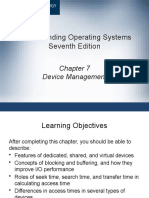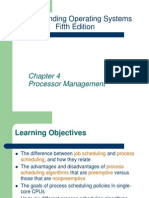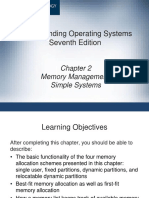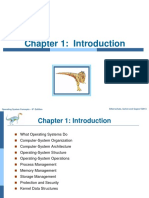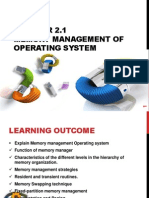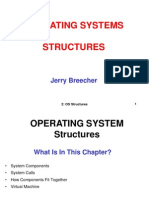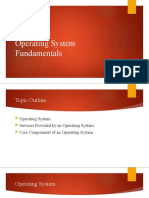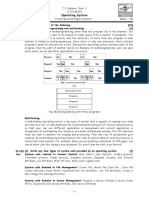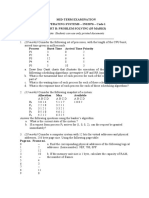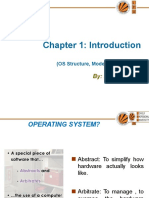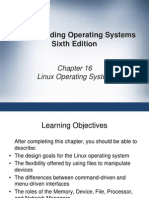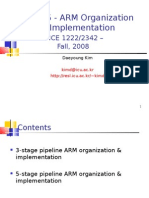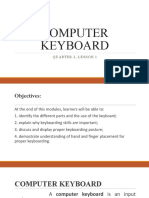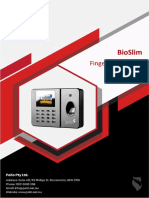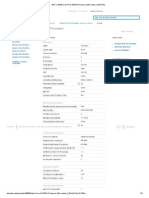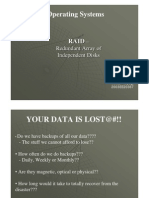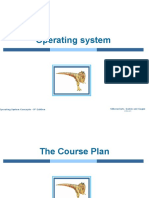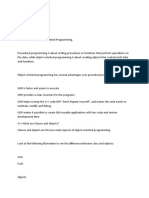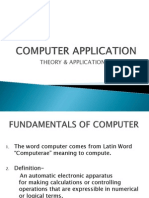Understanding Operating Systems Sixth Edition
Chapter 1 Introducing Operating Systems
�Learning Objectives
After completing this chapter, you should be able to describe: Innovations in operating systems development The basic role of an operating system The major operating system software subsystem managers and their functions The types of machine hardware on which operating systems run
Understanding Operating Systems, Sixth Edition
�Learning Objectives (cont'd.)
The differences among batch, interactive, real-time, hybrid, and embedded operating systems Multiprocessing and its impact on the evolution of operating system software Virtualization and core architecture trends in new operating systems
Understanding Operating Systems, Sixth Edition
�Introduction
Operating systems
Manage computer system hardware and software
This text explores:
What they are How they work What they do Why they do it
This chapter describes:
How operating systems work The evolution of operation systems
Understanding Operating Systems, Sixth Edition 4
�What is an Operating System?
Computer System
Software (programs) Hardware (physical machine and electronic components)
Operating System
Part of computer system (software) Manages all hardware and software
Controls every file, device, section of main memory and nanosecond of processing time Controls who can use the system Controls how system is used
Understanding Operating Systems, Sixth Edition
�Operating System Software
Includes four essential subsystem managers
Memory Manager Processor Manager Device Manager File Manager
Network Manager (fifth subsystem manager)
In all modern operating systems Assumes responsibility for networking tasks Discussed further in Chapters 9 & 10
Understanding Operating Systems, Sixth Edition 6
�Operating System Software (cont'd.)
Understanding Operating Systems, Sixth Edition
�Operating System Software (cont'd.)
Each manager:
Works closely with other managers Performs a unique role
Manager tasks
Monitor its resources continuously Enforce policies determining:
Who gets what, when, and how much
Allocate the resource (when appropriate) Deallocate the resource (when appropriate)
Understanding Operating Systems, Sixth Edition 8
�Operating System Software (cont'd.)
Network Manager
Operating systems with networking capability Fifth essential manager Convenient way for users to share resources Retains user access control
Resources include:
Hardware (CPUs, memory areas, printers, tape drives, modems, and disk drives) Software (compilers, application programs, and data files)
Understanding Operating Systems, Sixth Edition 9
�Operating System Software (cont'd.)
Understanding Operating Systems, Sixth Edition
10
�Main Memory Management
In charge of main memory
Random Access Memory (RAM)
Responsibilities include:
Preserving space in main memory occupied by operating system Checking validity and legality of memory space request Setting up memory tracking table
Tracks usage of memory by sections Needed in multiuser environment
Deallocating memory to reclaim it
Understanding Operating Systems, Sixth Edition 11
�Processor Management
In charge of allocating Central Processing Unit (CPU) Tracks process status
An instance of program execution
Two levels of responsibility:
Handle jobs as they enter the system
Handled by Job Scheduler
Manage each process within those jobs
Handled by Process Scheduler
Understanding Operating Systems, Sixth Edition
12
�Device Management
In charge of monitoring all resources
Devices, channels, and control units
Responsibilities include:
Choosing most efficient resource allocation method
Printers, ports, disk drives, etc. Based on scheduling policy
Allocating the device Starting device operation Deallocating the device
Understanding Operating Systems, Sixth Edition
13
�File Management
In charge of tracking every file in the system
Data files, program files, compilers, application programs
Responsibilities include:
Enforcing user/program resource access restrictions
Uses predetermined access policies
Controlling user/program modification restrictions
Read-only, read-write, create, delete
Allocating resource
Opening the file Deallocating file (by closing it)
Understanding Operating Systems, Sixth Edition 14
�Cooperation Issues
Essential manager
Perform individual tasks and Harmoniously interact with other managers
Requires incredible precision
No single manager performs tasks in isolation Network manager
Convenient way to share resources Controls user access
Understanding Operating Systems, Sixth Edition
15
�A Brief History of Machine Hardware
Hardware: physical machine and electronic components
Main memory (RAM)
Data/Instruction storage and execution
Input/Output devices (I/O devices)
All peripheral devices in system Printers, disk drives, CD/DVD drives, flash memory, and keyboards
Central processing unit (CPU)
Controls interpretation and execution of instructions Controls operation of computer system
Understanding Operating Systems, Sixth Edition 16
�A Brief History of Machine Hardware (cont'd.)
Understanding Operating Systems, Sixth Edition
17
�A Brief History of Machine Hardware (cont'd.)
Computer classification
By capacity and price (until mid-1970s)
Mainframe
Large machine
Physical size and internal memory capacity
Classic Example: 1964 IBM 360 model 30
CPU required 18-square-foot air-conditioned room CPU size: 5 feet high x 6 feet wide Internal memory: 64K Price: $200,000 (1964 dollars)
Applications limited to large computer centers
Understanding Operating Systems, Sixth Edition 18
�A Brief History of Machine Hardware (cont'd.)
Minicomputer
Developed for smaller institutions Compared to mainframe Smaller in size and memory capacity
Cheaper
Example: Digital Equipment Corp. minicomputer
Price: less than $18,000
Today
Known as midrange computers Capacity between microcomputers and mainframes
Understanding Operating Systems, Sixth Edition 19
�A Brief History of Machine Hardware (cont'd.)
Supercomputer
Massive machine Developed for military operations and weather forecasting Example: Cray supercomputer
6 to 1000 processors Performs up to 2.4 trillion floating-point operations per second (teraflops)
Uses:
Scientific research Customer support/product development
Understanding Operating Systems, Sixth Edition 20
�A Brief History of Machine Hardware (cont'd.)
Microcomputer
Developed for single users in the late 1970s Example: microcomputers by Tandy Corporation and Apple Computer, Inc.
Very little memory (by todays standards) 64K maximum capacity
Microcomputers distinguishing characteristic
Single-user status
Understanding Operating Systems, Sixth Edition
21
�A Brief History of Machine Hardware (cont'd.)
Workstations
Most powerful microcomputers Developed for commercial, educational, and government enterprises Networked together Support engineering and technical users
Massive mathematical computations Computer-aided design (CAD)
Applications
Requiring powerful CPUs, large main memory, and extremely high-resolution graphic displays
Understanding Operating Systems, Sixth Edition 22
�A Brief History of Machine Hardware (cont'd.)
Servers
Provide specialized services
To other computers or client/server networks
Perform critical network task Examples:
Print servers Internet servers Mail servers
Understanding Operating Systems, Sixth Edition
23
�A Brief History of Machine Hardware (cont'd.)
Advances in computer technology
Dramatic changes
Physical size, cost, and memory capacity
Networking
Integral part of modern computer systems
Mobile society information delivery
Creating strong market for handheld devices
New classification
By processor capacity, not memory capacity
Moores Law
Computing power rises exponentially
Understanding Operating Systems, Sixth Edition 24
�A Brief History of Machine Hardware (cont'd.)
Understanding Operating Systems, Sixth Edition
25
�Types of Operating Systems
Five categories
Batch Interactive Real-time Hybrid Embedded
Two distinguishing features
Response time How data enters into the system
Understanding Operating Systems, Sixth Edition 26
�Types of Operating Systems (cont'd.)
Batch Systems
Input relied on punched cards or tape Efficiency measured in throughput
Interactive Systems
Faster turnaround than batch systems Slower than real-time systems Introduced to provide fast turnaround when debugging programs Time-sharing software developed for operating system
Understanding Operating Systems, Sixth Edition 27
�Types of Operating Systems (cont'd.)
Real-time systems
Reliability is key Fast and time limit sensitive Used in time-critical environments
Space flights, airport traffic control, high-speed aircraft Industrial processes Sophisticated medical equipment Distribution of electricity Telephone switching
Must be 100% responsive, 100% of the time
Understanding Operating Systems, Sixth Edition 28
�Types of Operating Systems (cont'd.)
Hybrid systems
Combination of batch and interactive Accept and run batch programs in the background
Interactive load is light
Embedded systems
Computers placed inside other products Adds features and capabilities Operating system requirements
Perform specific set of programs Not interchangeable among systems Small kernel and flexible function capabilities
Understanding Operating Systems, Sixth Edition 29
�Brief History of Operating Systems Development
1940s: first generation
Computers based on vacuum tube technology No standard operating system software Typical program included every instruction needed by the computer to perform the tasks requested Poor machine utilization
CPU processed data and performed calculations for fraction of available time
Early programs
Designed to use the resources conservatively Understandability is not a priority
Understanding Operating Systems, Sixth Edition 30
�Brief History of Operating Systems Development (cont'd.)
Understanding Operating Systems, Sixth Edition
31
�Brief History of Operating Systems Development (cont'd.)
1950s: second generation
Focused on cost effectiveness Computers were expensive
IBM 7094: $200,000
Two widely adopted improvements
Computer operators: humans hired to facilitate machine operation Concept of job scheduling: group together programs with similar requirements
Expensive time lags between CPU and I/O devices
Understanding Operating Systems, Sixth Edition 32
�Brief History of Operating Systems Development (cont'd.)
1950s: second generation (cont'd.)
I/O device speed gradually became faster
Tape drives, disks, and drums
Records blocked before retrieval or storage Access methods developed
Added to object code by linkage editor
Buffer between I/O and CPU introduced
Reduced speed discrepancy
Timer interrupts developed
Allowed job-sharing
Understanding Operating Systems, Sixth Edition
33
�Brief History of Operating Systems Development (cont'd.)
1960s: third generation
Faster CPUs Speed caused problems with slower I/O devices Multiprogramming
Allowed loading many programs at one time
Program scheduling
Initiated with second-generation systems Continues today
Few advances in data management Total operating system customization
Suit users needs
Understanding Operating Systems, Sixth Edition 34
�Brief History of Operating Systems Development (cont'd.)
1970s
Faster CPUs Speed caused problems with slower I/O devices Main memory physical capacity limitations
Multiprogramming schemes used to increase CPU Virtual memory developed to solve physical limitation
Database management software
Became a popular tool
A number of query systems introduced Programs started using English-like words, modular structures, and standard operations
Understanding Operating Systems, Sixth Edition 35
�Brief History of Operating Systems Development (cont'd.)
1980s
Cost/performance ratio improvement of computer components More flexible hardware (firmware) Multiprocessing
Allowed parallel program execution
Evolution of personal computers Evolution of high-speed communications Distributed processing and networked systems introduced
Understanding Operating Systems, Sixth Edition 36
�Brief History of Operating Systems Development (cont'd.)
1990s
Demand for Internet capability
Sparked proliferation of networking capability Increased networking Increased tighter security demands to protect hardware and software
Multimedia applications
Demanding additional power, flexibility, and device compatibility for most operating systems
Understanding Operating Systems, Sixth Edition
37
�Brief History of Operating Systems Development (cont'd.)
Understanding Operating Systems, Sixth Edition
38
�Brief History of Operating Systems Development (cont'd.)
2000s
Primary design features support:
Multimedia applications Internet and Web access Client/server computing
Computer systems requirements
Increased CPU speed High-speed network attachments Increased number and variety of storage devices
Virtualization
Single server supports different operating systems
Understanding Operating Systems, Sixth Edition 39
�Threads
Multiple actions executing simultaneously
Heavyweight process (conventional process)
Owns the resources Passive element
Lightweight process (thread)
Uses CPU and scheduled for execution Active element
Multithreaded applications programs
Contain several threads running at one time Same or different priorities Examples: Web browsers and time-sharing systems
Understanding Operating Systems, Sixth Edition 40
�Object-Oriented Design
Driving force in system architecture improvements
Kernel (operating system nucleus)
Resides in memory at all times, performs essential tasks, and protected by hardware
Kernel reorganization
Memory resident: process scheduling and memory allocation Modules: all other functions
Advantages
Modification and customization without disrupting integrity of the remainder of the system Software development more productive
Understanding Operating Systems, Sixth Edition 41
�Object-Oriented Design (cont'd.)
Understanding Operating Systems, Sixth Edition
42
�Summary
Operating system overview Functions of OS
Manages computer system
Hardware and software
Four essential managers
Work closely with the other managers and perform unique role
Network Manager
Operating systems with networking capability
Essential hardware components
Memory chips, I/O, storage devices, and CPU
Understanding Operating Systems, Sixth Edition 43
�Summary (cont'd.)
Evolution of OSs
Run increasingly complex computers Run increasingly complex computer systems Prior to mid-1970s
Computers classified by capacity and price
Dramatic changes over time
Moores Law: computing power rises exponentially Physical size, cost, and memory capacity
Mobile society information delivery
Creates strong market for handheld devices Integral in modern computer systems
Understanding Operating Systems, Sixth Edition 44
�Summary (cont'd.)
Five categories of operating systems
Batch, interactive, real-time, hybrid, and embedded
Use of object-oriented design improves the system architecture Several ways to perform OS tasks Designer determines policies to match systems environment Next:
Explore details of operating system components
Understanding Operating Systems, Sixth Edition 45








